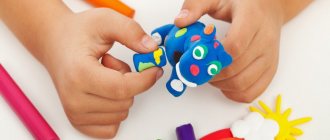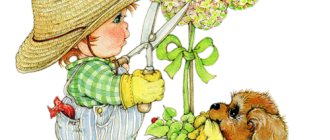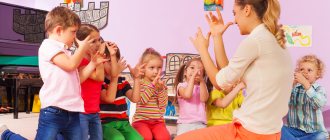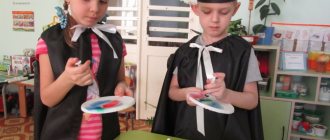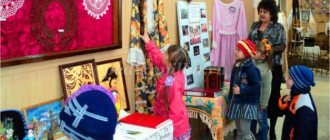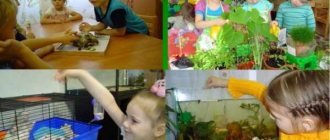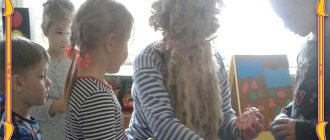Joint play activities of parents and children (from work experience)
This is my first year working with my group of children and parents.
I started by deciding to establish a trusting relationship with my parents. In modern conditions of a kindergarten it is so difficult to do without the support of parents, without their participation in the life of the group and kindergarten. Only through joint efforts can we raise a person who has a thirst for knowledge, knows how to enjoy life and sympathize, who can do anything! After all, it is through interaction and cooperation with parents that one can achieve the full development of a child and his proper upbringing. Interaction should be based on the principles of joint activities of educators, parents and children. At the same time, the goal of family education, as well as public preschool education, should be the development of the child’s personality.
The great Russian teacher V.A. Sukhomlinsky wrote: “Education is, first of all, human studies. Without knowledge of the child - his mental development, thinking, interests, hobbies, abilities, inclinations, inclinations, there is no education... Without constant spiritual communication between teacher and child, without mutual penetration into the world of each other’s thoughts, feelings, experiences, emotional culture as the flesh and blood of culture is unthinkable pedagogical". Of course, he wrote about teachers and educators, but we must not forget that the first teachers and educators for a child are his parents.
But modern parents, for some reason, forget about this and leave the upbringing, education and development of their children to general education institutions. I ran into a problem: parents show little interest in the success of their children. It is very difficult to attract and interest them, but this is the most important task. It is sometimes so difficult to explain to parents that the child must not only be fed, clothed, and put to bed, but also communicate with him, teach him to reflect, think, and empathize. And how great it is to do everything together - play, walk, talk about different topics, share secrets, come up with different stories, do crafts. This is what I want to convey to the parents of my students by holding unusual conversations with them, consultations, seminars, workshops, parent meetings on various interesting topics that concern them so much. I rely on the requests of parents, and these requests are easy to identify through questionnaires, and sometimes I cover those topics and questions that are of interest to us educators and, I think, will be of interest to parents.
Yes, parents now are all literate people, with higher education, but, according to my observations, they do not know how to build relationships with children in play activities. But play is one of the leading activities of a child. Now the children stop playing. And the games children play have become sad and aggressive. The chain of transmission of gaming tradition from one generation to another has been broken. I decided to bring children and parents closer together, to show parents that their children are creative and capable, but they require attention and a partner to play with.
To solve this problem, I set myself the following tasks in working with parents:
1. To develop in parents confidence in their own pedagogical capabilities, the ability to know and understand their children.
2. Enrich the emotional joint experience of family members, teach interaction skills between them through gaming activities.
3. Develop an interest in children and parents in spending time together.
4. To unite parents and children, to ensure that children understand their parents, and parents understand their children.
5. Introduce parents to the traditions and forms of gaming leisure in families.
6. Help parents discover new opportunities for the child to reflect the world in play.
In order to find out the meaning of joint games in the families of my students, I conducted a survey of parents and children “Game in the life of my family.” Based on the results of the survey, I concluded that parents want to play with their children, but do not know how to properly organize joint play activities with their children.
I drew up a plan for joint gaming activities, where parents will be partners, participants in children’s games, and not spectators or observers.
Prepared consultations for parents “Growing up while playing”, “What toys do your children need?” The goals of these consultations are: to make parents understand what role play plays in the child’s life; give knowledge about the meaning of the toy, its role in the child’s play.
My next step was to hold a parent meeting in the form of an oral journal on the topic “Why does a person need childhood?” At the meeting, questions were discussed: do parents remember their childhood, what is characteristic of it? What interests and worries their child? How would they like it to be? At the meeting, parents got acquainted with the statements of teachers and scientists about the game and its role in the life of the child. At the end of the meeting, parents received instructions on “How to play with your child correctly.”
There are many forms of organizing joint work between educators and parents. One of these forms is holding competitions, entertainment, holidays among parents, among parents and employees, etc. in kindergarten. The kindergarten traditionally celebrates the New Year on March 8 and February 23. But I realized that children’s lives become more interesting if we organize some non-standard, fun holidays, to which parents are invited not only as spectators, but also as participants.
A holiday is a bright event in a child’s life, filled with unusual, joyful and deep impressions. K.D. Ushinsky wrote: “Let everyone remember his childhood, and he will see that a holiday for a child is not at all the same as for us, that this is really an event in a child’s annual life, and that a child counts the days from holiday to holiday, just like we do.” We count our years from one important event to another.” I agree with him. But the holiday is doubly interesting for children if parents take part in it.
It has become a good tradition for our group to hold parent-child celebrations. This is a good reason to spend them with your parents, not for them. The scenarios are drawn up in such a way that parents are direct participants in the holiday. This involves cooperation with parents and communication with children through joint activities. Such holidays take more than one day to prepare. This is painstaking work. It is necessary to think over the organization of the holiday, the decoration of the hall, develop a script, etc. With children, before each event, I make invitations for parents. How nice it is to see the joyful faces of parents when their child presents an invitation made with their own hands! It would be a shame not to come and take part in order to please your son or daughter.
Holidays: “Autumn Birthday”, “Christmas Tree Festival”; leisure activities: “Together with Mom”, “Wide Maslenitsa”; entertainment: “Winter fun”, “Mom is my sunshine”, “Dad can do anything!” and others were held with various attractions, competitions, competitions, relay races and other game subjects. Mothers, grandmothers, fathers and their children took part in them. These events not only bring parents and children together, but also create an atmosphere of warmth and trust in the relationship between the teacher and parents. You learn a lot of interesting things about the families of your students, about their traditions, hobbies, about the system of raising children in the family, and most importantly, parents reveal their talents and creative abilities that they didn’t even know about. The unique emotional and spiritual atmosphere of the holiday is created by the general mood and activity of all participants in the holiday: children, parents, teachers. Joint holidays with parents remain in the memory of adults and children for a long time. They teach the child to love and take care of his family, his father and mother, the spirit of his home. Parents get to know each other well in joint competitions, competitions, and relay races. Adults and children learn to understand each other better, and parents have the opportunity to observe their child’s interactions with others. Children see a positive example of communication and relaxation.
I saw that as a result of such events, parents changed their attitude towards the child (he can and knows a lot) and towards us, the educators who work with their children every day, putting their soul, knowledge and strength into the work of education.
A special place is occupied by exhibitions of joint creativity between parents and children, for example, “Autumn is a Magician”, “Magic Snowflake”, “Crazy Hands”. The main goal of such events is to bring generations (children, parents, grandparents) closer together and strengthen child-parent relationships. In addition, exhibitions of joint creativity foster hard work, accuracy, attention to loved ones, and respect for work. This is the beginning of patriotic education, because love for the Motherland is born from a feeling of love for parents, one’s family.
Especially loved by children are “Meetings with Interesting People”, where their guests are parents who introduce themselves to children in a different way - as professionals in their field, interesting people. For example, the guests of our group were my mother, a doctor from a railway clinic, and my father, a builder. Such meetings enrich children's knowledge about the professional activities of adults, expand their general awareness of the world around them and their horizons, and also form in them a certain elementary experience of professional actions and promote early “professional orientation.” Role-playing games of a professional orientation play a major role in shaping children’s ideas about the professional activities of adults. Therefore, the result of such meetings are role-playing games, for example, “Polyclinic”, “Why should we build a house?”
I also plan to invite my grandmother to visit, who will show her crocheting skills; a mother who agrees to organize a “Balloon Festival” for the children.
We must not forget that our kindergarten is from the railway. I plan to hold a literary lounge “Here is our train rushing, the wheels are knocking...”, where parents and children will read poems, fairy tales, stories about the railway, their own compositions.
I believe that thanks to such events I create conditions for interaction between children and parents, which helped improve emotional contact between them and taught them how to play together.
Author: Irina Aleksandrovna Safarova, teacher, NDOU “Kindergarten No. 118 of JSC Russian Railways”, Samara, Russia.
The article is published in the author's edition.
Joint activities with children: 5 interesting options
Quite often, parents believe that their joint activities with their child will not bring the desired effect. After all, in order to raise a comprehensively developed personality, we need specialists who master the most modern techniques.
In addition, mothers often refer to lack of time: “When should I draw with my child? I barely have time to feed him, check his lessons and go grocery shopping... Why waste precious free minutes on this?”
Of course, developmental circles are useful for any child, but they do not exclude or replace joint activities with loved ones. After all, it is at home that children can try in practice what they were taught in the courses. In addition, only at home can a child develop the most important social skills - the ability to listen, conduct dialogue, show participation, care for others and express his feelings. Without parental support, a child simply cannot learn all this.
1 Family Collection
Especially recommended for overly emotional and anxious children.
Gathering is a very rewarding activity. It gives us a feeling of stability. Have you noticed that often, after experiencing emotional excitement, kids shake out all their toys and, sorting through them, gradually calm down? Or do they carefully arrange cars and dolls in a certain way before going to bed? This ritual has a calming effect on them. Having grown up, children refuse stuffed hares, and just at this moment parents can invite them to collect something together.
If you already have a ready-made collection, invite your child to add to it. You can combine this process with the study of history, physics or something else. The topic depends on the subject of the collection. But whatever it is, such an activity is a great way to bring children and parents together. You can start now!
2 Go study
Especially recommended for: insecure primary schoolchildren and teenagers.
There are situations that seem to be specially created to praise children. That is, tell them how talented they are (smart, resourceful, etc.) immediately at the moment of success. You can, for example, study languages together. Or go to a dance with your daughter, and take a computer graphics course with your son.
In a co-education situation, the child feels “on an equal footing” with his parents. He gets the opportunity to show that he is better than adults in some ways, and truly shines before our eyes. Don't hesitate to ask him for help if you can't understand a rule or learn a difficult move. For children - both toddlers and teenagers - such moments add self-confidence. The child also gains the most important experience of support. The opportunity to encourage your mother (“don’t worry, you will succeed!”) and help her achieve what she wants is priceless. And it greatly strengthens self-confidence.
3 We can do it!
Especially recommended for: children who are not responsible enough.
The opportunity to help mother with housework creates a child’s sense of self-worth and, most importantly, teaches him to bear responsibility. The main condition of the process is to do everything together. The directive scheme “I bake a cake, and then you wash the dishes” is not suitable. After such instructions, any housework becomes a boring chore. The task of adults is to turn it into a joint game, and then the child will perceive even washing the floors as an adventure. Among other things, this is also a great way to relieve all family members from the feeling of “household routine”.
Do not miss
- Do not miss
Fun with kids: 11 ways to make slime from shampoo (you'll love it too)
4 Expressing feelings
Especially recommended for: introverted children who have difficulty expressing their feelings.
Parents of an introverted child sometimes have no idea what worries, upsets, or, conversely, makes him happy. He constantly holds back his emotions. Over time, secrecy becomes almost the main character trait, and then it becomes almost impossible to force a person to be frank. Free creativity will help teach your child to express and share emotions. It provides a huge toolkit that allows you to talk about your joys, sorrows and fears without words (introverts have plenty of them). The adult’s task is to show the child all the ways that are acceptable for working with feelings. Clubs are more focused on the technical side of the process, and parents can help their child “have a blast.”
5 Don't rush anywhere
Especially recommended for: children experiencing lack of attention.
Lying on the couch, playing with a kitten, thinking “what should I do?” - it’s so meaningless, aimless and... very useful. For a child, moments of relaxed “doing nothing” with their parents become one of the most pleasant and warm memories. The secret is that we can only laze around from the bottom of our hearts with truly dear people. The lazy activity of “nonsense” sometimes turns out to be the most bonding thing: adults do not make comments to the child, do not read notations, do not remember the “C in algebra,” but simply enjoy life with him. The time when we are together and not in a hurry is the most valuable time for a family!
Top 5 board games
Board games are perhaps the most accessible form of family entertainment. This is a useful, fun and exciting activity. Moreover, there are many games that are equally interesting to kids, teenagers, and mom and dad.
✓ “Monopoly” from 5 years, minimum 3 players. This classic economic strategy with fun twists has been at the top of the list of the world's most popular board games for many years. Gambling, witty and extremely useful (learning to count money) entertainment for all family members.
✓ “Nonsense” from 3 years old, minimum 2 players. This game develops speech, imagination and... a sense of humor! “Nonsense” does not require any costs: take a notebook and pencils and invite all participants to take turns writing words, so that the result is a funny story. Crazy stories are welcome!
✓ “Ropes and Dragons” from 6 years old, minimum 3 players. An educational and witty strategic thinking trainer. You throw the dice, make a move on the playing field and receive a certain task (they are written on the cards). Until you cope, you won’t go further. The winner is the one who reaches the finishing point first.
✓ “Danettes” from 5 years old, minimum 3 players. The presenter takes a card from the deck and reads aloud the story written on it (the explanation is written on the back and the presenter knows it). The participants' task is to get to the bottom of the story by asking questions that can only be answered with “yes” or “no.” The one who names the correct answer first becomes the new leader.
✓ “Bazinga” from 12 years old, minimum 4 players. Two teams with an even number of players compete against each other. Using special cards and a tape measure, a word is selected (there are different levels of difficulty), which must be drawn, shown in pantomime, or described without using the same root words.
Text: Svetlana Ievleva
MAGAZINE Preschooler.RF
Preschoolers working in pairs: methods and techniques for organizing joint activities of childrenThe ability to interact in pairs is one of the most important. It has special significance. The meaning of the method of children working in pairs is that the task is not given to each child of the group individually, but to a pair of students who must complete it together. Interaction in a couple is a type of joint activity that is ensured by communication, and this communication should be aimed at ensuring the success of this interaction.
Our group consists of preschoolers of different ages, where the age of children ranges from 4 to 7 years.
Distinctive features of working in a preschool mixed-age group:
- there are few children of the same age, there are no clashes of interests, there is no worthy competition;
- children are not taught to recognize the positions of “leader” and “subordinate” , change situations, and subordinate.
Our task was to find ways to solve the problem of interaction between children of different ages. The goal is to provide comfortable conditions and a friendly communication environment for the interaction of preschoolers of different ages.
To successfully complete a task together, the following pedagogical methods and techniques aimed at group interaction and cooperation in productive activities can be applied:
- using a motivational component when setting goals (make a gift or craft for someone)
- developing in children the ability to recognize a situation of cooperation, choose and accept a position in social relations that corresponds to their capabilities in this activity (the ability to listen and take into account the opinions of others when making collective panels, collages)
- acting out problem situations (by implementing these situations, the teacher influences the feeling of compassion, which is available in preschool age, encourages children to sympathize and empathize when solving the task)
- situations of moral choice (when awareness of the most important moral categories is comprehended by preschoolers based on specific actions in relation to peers: help in completing a started craft, etc.).
Organizing the work of children in pairs includes four stages:
The first is a verbal designation by adults of the situation of the lesson (reminding the rules of the game or the content of productive activities, discussing with the children an adequate way to complete the task together).
The second is pair formation (the natural union of preschoolers of their own free will; adult help for children who have difficulty choosing partners).
The third is the actual interaction of the child with a peer (independent distribution of responsibilities in a pair, division of operations, joint completion of a task, help from an adult in cases where disagreements arising between children can lead to the destruction of joint actions). If pairs of preschoolers do not cope with the task, the appropriate method of interaction is once again discussed with them.
We discuss inevitably arising conflict situations and negative behavior of children only with a specific pair of preschoolers, without attracting the attention of other peers. We provide children with the opportunity to express their complaints against each other, their assumptions about why something did not work out for them, and we offer to continue completing the task, taking into account the experience gained.
Therefore, the preliminary work of the teacher is the main condition for the interaction of children in pairs. The teacher should emphasize the importance of the couple’s agreement in order for the goal of joint activity to be achieved (creating a drawing, craft, picture, any product of joint activity).
The fourth stage is the analysis and evaluation of activity products. At this stage, the leading role remains with the teacher, who, after completing the task, organizes an exhibition of children's works, draws the children's attention to the works of their peers, invites them to examine them, compare them with their own, while giving an example of a friendly, constructive assessment.
Let us give examples of pair work in the educational field “Artistic and Aesthetic Development” .
For work to be productive, preschoolers need to be taught to work in pairs. To do this, you first need to gradually introduce simpler exercises. For example: the exercise “Mittens” involves children from 5 years old.
To play the game you need mittens cut out of paper, their number is equal to the number of pairs of participants in the game. The teacher hands out one mitten to the children. The children find their “pair” and, using three common pencils of different colors, try to color the mittens exactly the same as quickly as possible. The teacher observes how the pairs organize their joint work, how they share pencils, and how they negotiate. The winners are congratulated.
Preschool children respond with pleasure to the creation of joint works, as a result of which they feel the importance of each child in the creation of collective work and understand that this common work was achieved thanks to the efforts of each child. Techniques for working in pairs help children visually see how they can create joint work. Following the example of adults, children begin to use new ways of interacting with their partners, which are necessary for creating collective works.
Another simple example: when preparing for the New Year, you can invite children to make a beautiful chain from colored paper to decorate the group. We ask how we will work. We listen to the children's answers. Most want to work alone and promise that they will make the longest chain. Then we suggest: “Let's try to work in pairs. One child will cut strips of paper, the other will glue them together . Children work with pleasure. While working, they communicate, help each other, and are happy with the results obtained. They are especially pleased when, after admiring all the chains made, they are offered to connect them into one big one.
The entire process of work takes place in discussion: discussion of the plan, distribution of materials, direct execution of the work, since working in pairs involves discussing all the points. The guys talk to each other and thereby develop their communication skills.
Along with creative tasks, the tasks of moral education are solved, namely: choosing a place for your work on a collective panel, doing the work without interfering with each other, coming to the aid of a younger comrade.
When working in pairs, children learn to communicate, control each other, and find compromises. The teacher tells and shows how to do it correctly. Talk calmly, be able to listen to others, construct a sentence correctly. The teacher pays special attention to the phrases that the children exchange. This is important when one child takes the role of “leader” and the second “subordinate” .
Moreva Margarita Vasilievna
Sokolova Svetlana Vyacheslavovna
correctional group teachers
GBDOU kindergarten No. 56 combined type
Kolpinsky district of St. Petersburg
| Next > |
Kindergarten and parent - difficulties in interacting with parents
The authors of some works write that educators often have some difficulties in interacting with parents.
Often parents may have poor development of social culture. They do not understand how valuable it is to raise their child during the preschool period.
Many parents do not realize that they should be the ones who order the organization of the process of raising their children. They are the ones who should influence the content of the educational program in kindergarten. Often parents are not even interested in what happens to their children within the walls of the kindergarten. On the other hand, educators also often do not know the conditions in which the child grows up at home.
Often teachers do not perceive parents as partners. They often believe that parents are also objects of education. In fact, a kindergarten will only be able to fully satisfy the needs of the child if it represents an educational and educational system open to parents.
Parents should have the opportunity to get acquainted with the conditions of their child’s stay in the kindergarten at any time without obstacles. He must have information about what approaches teachers have to education. He must take an active part in the life of the group. Usually, if you observe a child in an unusual environment, you can learn a lot about him.
